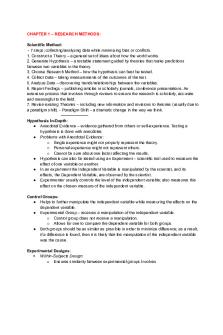Psych 3F03 Lecture 10 Fear and Fleeing PDF

| Title | Psych 3F03 Lecture 10 Fear and Fleeing |
|---|---|
| Author | Amir Kadir |
| Course | Evolution and Human Behaviour |
| Institution | McMaster University |
| Pages | 2 |
| File Size | 56.9 KB |
| File Type | |
| Total Downloads | 100 |
| Total Views | 141 |
Summary
Download Psych 3F03 Lecture 10 Fear and Fleeing PDF
Description
Learning objectives ● Learn 6 ways in which fear and anxiety can benefit and protect individuals ● Understand how fears to specific stimuli can be explained by our evolutionary past ● Learn and describe two theories that may explain varying rates of senescence Fear ● ●
●
An emotional response to a threatening or potentially dangerous stimulus/situation Fear is a vital evolutionary legacy that leads an organism to avoid threat, and has obvious survival value. It is an emotion produced by the perception of present or impending danger and is normal in appropriate situations. Without fear few would survive long under natural conditions (Marks, 1987) Fear is processed in the amygdala
Responses to fear ● 1. Freezing: allows assessment of the situation and helps conceal from predator if you aren’t sure if you’ve been spotted yet ● 2. Fleeing: allows to distance self from threats ● 3. Fighting: attacking threat with physical force in hopes of turning the tables ● 4. Submission or appeasement: submissive body language that implied lack of threat (usually to member of own species) ● 5. Playing dead: feigning or faking death when fighting or fleeing is futile ○ Predators are sensitive to motion and there is a chance they may lose interest in a motionless animal ● 6. How is fainting adaptive: fainting is a loss of consciousness to signal to the attacker one is not a threat ● Does it increase the chance of non-combatants surviving a conflict? ● Blood injection-injury type specific phobia (BIITS) ○ 4.4% of women; 1.8% of men ○ Median age onset is 5.5 years Physiological responses to fear ● There is a release of epinephrine ( adrenalin) from the adrenal glands ○ Aids in blood clotting ○ Increases glucose release ○ Increases heart rate ○ Increases blood flow to muscles ○ Increases breathing rate Anxiety disorder and evolution ● Can anxiety (and other physiological disorders) be explained by evolutionary past? ● Modern life is very different to what we adapted to: ○ - first world problems may represent ambiguous threats that complicated to solve ● Perception of social status is complicated in the world of social media
Specific fears ● Humans are adapted to respond to specific stimuli that may have represented real dangers for our ancestors ○ E.g. chance of dying in a motor accident (103) ○ Chance of dying from a snake (1 in 50 million) ○ Infants react differently to evolutionarily relevant fears ○ Fear of spiders are very specific Fear of public speaking and social status ● Increased fear when: ○ 1. Lack of experience ○ 2. Degree of evaluation ○ 3. Status difference ○ 4. New ideas Why die? ● Senescence: the deterioration of all bodily mechanisms as organisms grow older ● 1. Life history trade-offs: investment into reproduction is metabolically costly and can trade-off with longevity ○ I.e. live fast die young - increased reproduction = decreased lifespan ○ Female fruit flies who mate more early in life die younger ● 2. Pleiotropic theory of senescence: ○ Some genes that improve fitness early in life, have negative consequences for fitness later in life ○ Pleiotropy: when one gene has two or more different effects ○ The power of natural selection decreases with increasing age ○ E.g. testosterone, competition, and prostate cancer risk ○ Is this why women tend to live longer than men? Suicide ● Suicide adaptation hypothesis: suicide most likely to occur when an individual has a dramatically reduced ability to contribute to his or own inclusive fitness ● E.g. poor future health, disgrace or failure, poor mating prospects or infertility ● Connection to inclusive fitness: perception of being a burden ●...
Similar Free PDFs

Psych 10
- 2 Pages

Psych Notes 10/10 & 10/12
- 2 Pages

Chapter 10 (Social Psych)
- 7 Pages

Psych Notes Chapter 10
- 12 Pages

Psych chapter 10
- 65 Pages

3.05 Fascination With Fear
- 2 Pages

Lecture Notes (Psych)
- 43 Pages

Psych 100 - lecture notes
- 20 Pages
Popular Institutions
- Tinajero National High School - Annex
- Politeknik Caltex Riau
- Yokohama City University
- SGT University
- University of Al-Qadisiyah
- Divine Word College of Vigan
- Techniek College Rotterdam
- Universidade de Santiago
- Universiti Teknologi MARA Cawangan Johor Kampus Pasir Gudang
- Poltekkes Kemenkes Yogyakarta
- Baguio City National High School
- Colegio san marcos
- preparatoria uno
- Centro de Bachillerato Tecnológico Industrial y de Servicios No. 107
- Dalian Maritime University
- Quang Trung Secondary School
- Colegio Tecnológico en Informática
- Corporación Regional de Educación Superior
- Grupo CEDVA
- Dar Al Uloom University
- Centro de Estudios Preuniversitarios de la Universidad Nacional de Ingeniería
- 上智大学
- Aakash International School, Nuna Majara
- San Felipe Neri Catholic School
- Kang Chiao International School - New Taipei City
- Misamis Occidental National High School
- Institución Educativa Escuela Normal Juan Ladrilleros
- Kolehiyo ng Pantukan
- Batanes State College
- Instituto Continental
- Sekolah Menengah Kejuruan Kesehatan Kaltara (Tarakan)
- Colegio de La Inmaculada Concepcion - Cebu







